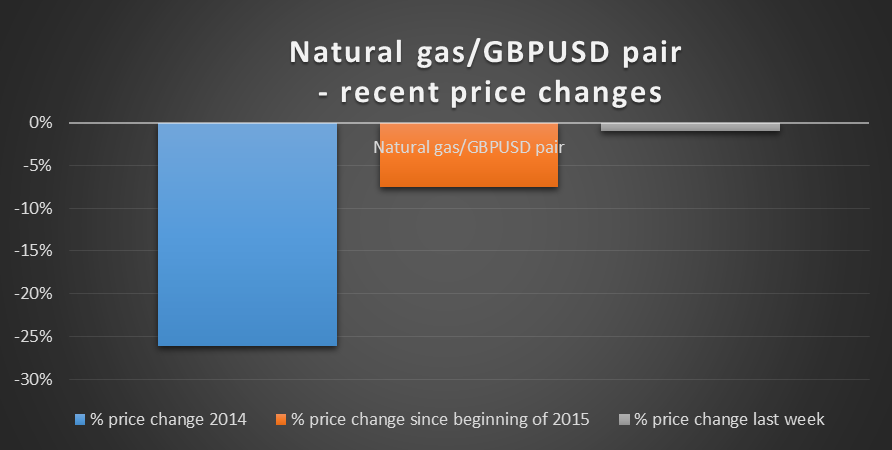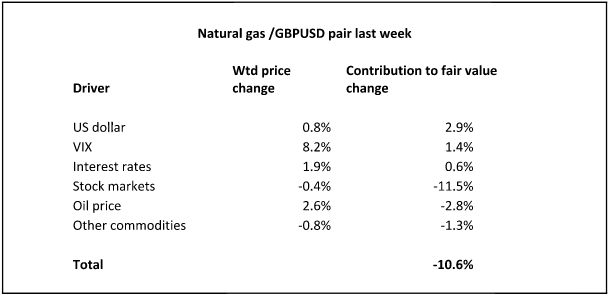For some time, the natural gas price has significantly underperformed the pound sterling against the US dollar. The result has been a decreasing price of the commodity pair: long natural gas, short GBP/USD. The graph below shows the performance of a pair ratio of 10 Mmbtu natural gas (long) to GBP 10,000 (short).

Both have been declining in US dollar price; the decrease in the price of the pair has reflected steeper falls in the price of natural gas.
Over the last week, the natural gas price fell 1.9% (to $2.64) whilst GBP/USD declined 0.9% (to $1.4812) to give a 0.9% decrease in the price of the pair. This was accompanied by a 10.6% fall in its fair value, largely driven by movements in stock markets and commodity prices. The table below analyzes the move:

An excess of fair value decrease over price decrease would normally be a signal to sell or go short the pair (ie. to short natural gas, buy GBP/USD). Following this signal over the last 90 days would have provided an annualized gain (on gross – long plus short - exposure) of 57.0% with volatility of 17.7%.
We have also applied this methodology to a number of other pairs of related securities – EURUSD/gold, gold/GBPUSD, DAX/S&P 500, palladium/copper, ASX 200/FTSE, CAC 40/Nikkei and oil/EURUSD. The portfolio of all these pairs traded using the disparity between price and fair value change (as above) has returned an annualized 35.4% with volatility of 4.8% over the 90 day backtest period.
We find a fair value of the natural gas/GBPUSD pair above the current price, suggesting that the pair is undervalued and providing the opposite signal to that analyzed above. Trading the pair using this indicator over the 90 day backtest period showed a 10% annualized return with volatility of 18%. For the portfolio of pairs described above, the annualized return was breakeven. Hence we note the signal, but tend to discount it in favor of the stronger performing price/fair value change disparity indicator.
Risk considerations
The graph below shows the sensitivity of the pair’s fair value to its drivers:

As can be seen, the natural gas/GBPUSD pair is highly positively correlated to the US dollar, not surprising given the positive relationship between USD and the natural gas price and therefore both positions in the pair. Our fair value indicators suggest some short term upside in the US dollar index which would pose a risk to the pair trade (long GBPUSD, short natural gas) recommended above.
The USD may undergo some volatility later this week if the jobs data reads come in some distance from consensus. Given the sensitivity of the pair to the USD evident in the above graph, this could translate into volatility in GBPUSD and the natural gas price. GBP could be impacted by the Q4 UK GDP print today (Tuesday).
The historical volatility of the pair over the last 90 days, at 18%, is well below the volatility for natural gas (69%) although above GBPUSD volatility (9%).The pair trade can be thought of as a low risk way of taking on exposure to natural gas.Using our price/fair value movement indicator as underpins this article, the return/volatility ratio from trading the natural gas/GBPUSD pair, at 3.2 times, compares favourably to that for trading outright natural gas (2.8 times).
Held in combination with a US equity portfolio, lower volatility and higher return may be achieved. A portfolio of 5% allocated to the pair (traded as recommended in this article) and 95% allocated to the S&P 500 index had a volatility of 12.6% over the last 90 days vs 13.2% for 100% in the S&P 500. The annualized returns were -1.2% (5% allocated to pair) vs -4.5% (100% S&P 500).
